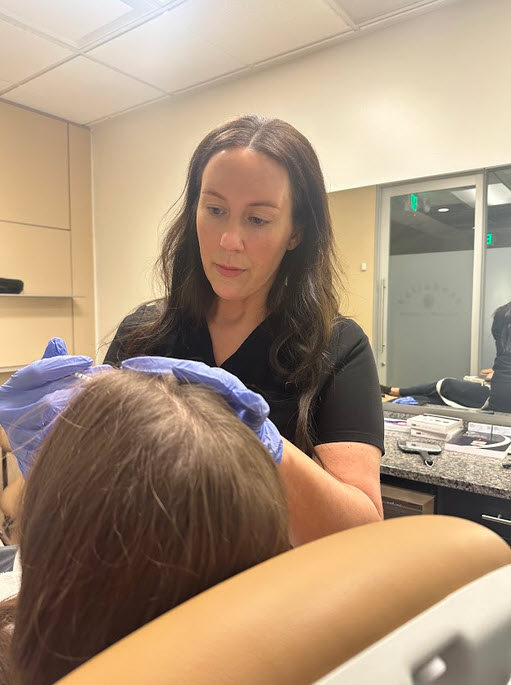Which Is Better?
When it comes to treating acne scars, two of the most effective professional options are microneedling and chemical peels. But determining which is better for your skin—microneedling or chemical peels—depends on several factors, including the type and severity of your scars, your skin tone, and how much downtime you’re comfortable with. Here’s a closer look at how each treatment works and what to expect.
Microneedling for Acne Scars
How it works:
Microneedling, also called collagen induction therapy, uses a device equipped with fine needles to create tiny, controlled punctures in the skin. These micro-injuries stimulate the body’s natural healing response, encouraging the production of collagen and elastin. As your skin heals, it becomes smoother, firmer, and more even in texture.
Benefits for acne scars:
Microneedling is particularly effective for treating atrophic or indented scars—such as icepick, rolling, and boxcar scars. Some of the top benefits include:
- Visible improvement in skin texture and tone
- Smoothing of mild to moderate depressions in the skin
- Safe for all skin tones, including darker complexions (with minimal risk of hyperpigmentation)
- Gradual enhancement of collagen and elastin over time
Downtime and side effects:
Microneedling typically involves minimal downtime. You may experience redness, mild swelling, or light flaking for a few days after treatment. However, it’s important to avoid this procedure if you have active acne, open wounds, or skin infections, as it may worsen inflammation.
Possible side effects can include:
- Redness or irritation
- Temporary flaking or dryness
- Risk of infection or pigmentation changes if not performed by a qualified provider
Best for:
Patients with deeper or pitted acne scars and uneven skin texture who prefer a minimally invasive approach with little downtime.
Chemical Peels for Acne Scars
How it works:
Chemical peels involve applying a specialized acid solution to the skin to exfoliate and remove the outermost layers. This process encourages skin regeneration and can significantly improve tone, texture, and scarring over time. Peels vary by depth:
- Superficial Peels: Exfoliate only the epidermis; ideal for mild discoloration and shallow scars.
- Medium-Depth Peels: Reach the upper dermis and treat moderate scarring and uneven texture. TCA (Trichloroacetic Acid) peels are a common option.
- Deep Peels: Penetrate the lower dermis and are used for severe scarring, but require a longer recovery and involve more risk.
Benefits for acne scars:
Chemical peels can offer significant improvement in:
- Superficial scarring and discoloration
- Post-inflammatory hyperpigmentation (PIH)
- Uneven skin tone and surface texture
- Some active acne conditions (e.g., salicylic acid peels can reduce oil and unclog pores)
Downtime and side effects:
Recovery depends on peel depth:
- Superficial peels: 1–2 days of mild redness or flaking
- Medium peels: 7–10 days of redness, peeling, and tenderness
- Deep peels: Weeks of healing and potential side effects
Side effects may include:
- Redness, peeling, and temporary sensitivity
- Hyperpigmentation, especially in darker skin tones
- Possible scarring if improperly applied
- Not suitable for patients with a history of cold sores or certain medications
Best for:
Patients with superficial acne scars, uneven pigmentation, or active acne who can tolerate moderate to longer downtime.
Combination Treatments: A Holistic Approach
For many individuals, combining microneedling and chemical peels produces superior results. Microneedling can target deeper structural scarring, while a chemical peel—especially a superficial one—can improve pigmentation and surface-level concerns. This dual approach should always be performed by a licensed and experienced aesthetic provider to avoid irritation and optimize outcomes.
Conclusion: What’s Right for You?
So, microneedling vs. chemical peels for acne scars—which is better? The answer lies in your unique skin concerns, goals, and how aggressive you want to be with treatment.
- Choose microneedling if you have deeper, indented scars and want a collagen-boosting solution with minimal downtime.
- Opt for chemical peels if your primary concern is pigmentation, texture irregularities, or if you’re dealing with active breakouts.
- Consider both if you’re looking for comprehensive rejuvenation and long-term improvement.
Before deciding, consult with a board-certified provider or skin care expert who can evaluate your scar type, skin history, and treatment goals.
💡 Ready to Improve Your Skin?
At Bellaboxx Aesthetics, our experienced skincare specialists in Bellevue and Tacoma offer personalized treatments using both microneedling and medical-grade chemical peels. Whether you’re looking to smooth out acne scars, brighten your complexion, or improve skin texture, we’ll create a treatment plan tailored to your needs.
👉 Book your consultation today and take the first step toward healthier, more radiant skin.
